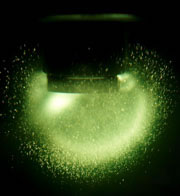Un peu de technique "en vrac"
DOCUMENTS DE BASE
La "SONOFUSION" ?
DOCUMENTS DE BASE

| Nuclear engineer Rusi Taleyarkhan's
claims that he had achieved table-top fusion in collapsing bubbles caused
a storm when they were first reported in Science in 2002. If the
effect is real, and could be harnessed, it might one day provide an almost
limitless source of energy.
Four years later, Taleyarkhan's work retains an almost magical ability to grab the headlines, most recently in January, when his latest claims were promoted in a press release by the American Physical Society, and Science defended its initial publication of the work in an editorial as recently as 3 March. Millions of dollars are being spent trying to repeat the work, including $800,000 from the US Department of Defense. But corroboration remains elusive. Taleyarkhan and his co-authors vigorously affirm that the effect they have seen is real, and have published several further positive studies - most recently in Physical Review Letters, in which they claim to have countered previous technical objections to their work. Yet there has been no independent confirmation of their results, and an investigation by Nature of the circumstances surrounding the experiments reveals serious questions about their validity. |
Interviews with researchers who have worked closely with Taleyarkhan
at Purdue University in the past two years, a re-analysis of his data by
a group critical of him, as well as a review by the US patent office, suggest
that serious doubts are prevalent in the physics community.
Purdue University did not promote Taleyarkhan's most recent paper to the media. This may reflect the fact that other faculty members at the university, who are trying to repeat the work, have been concerned by Taleyarkhan's actions since he arrived there full-time in 2004. The steps he has taken, they say, include claiming positive results from equipment on which they had seen only negative data, before removing the equipment from their lab altogether (see 'Is bubble fusion simply hot air?'). Brian Naranjo of the University of California, Los Angeles, has now completed an analysis suggesting that the spectrum reported in Taleyarkhan's latest paper as proof of nuclear fusion came instead from the radioactive decay of standard lab material (see 'Bubble bursts for table-top fusion'). |
Source ADIT, mars 2006:
| R. P. Taleyarkhan, C. D. West, R. T.
Lahey Jr., R. I. Nigmatulin, R. C. Block, Y. Xu - Physical Review Letters:
"Sonofusion works, according the latest volley in the argument over the feasibility of acoustically driven nuclear fusion. A collaboration of researchers from Purdue University and Rensselaer Polytechnic Institute has detected neutrons, with energies typical of certain fusion reactions, emanating from a container of a specially prepared mixture of benzene and acetone that was exposed to high frequency sound waves. The sound waves produce tiny bubbles, which expand and then rapidly contract, generating high temperatures that the researchers believe lead to nuclear fusion reactions. |
The group announced similar results about two years ago, but faced ardent criticism over aspects of their experimental set up that could have created false positives in their data. In the earlier experiments they had used a beam of neutrons in an attempt to initiate the bubbles leading to sonofusion reactions. Critics claimed the beam could have been mistaken for neutrons emitted by fusion reactions. In the new experiments, the researchers dissolved natural uranium into the solution, which acts as a source of bubble-initiating neutrons. They claim that the new technique eliminates any confusion in identifying the neutrons they measured coming from the experiment as the products of sonofusion reactions." |